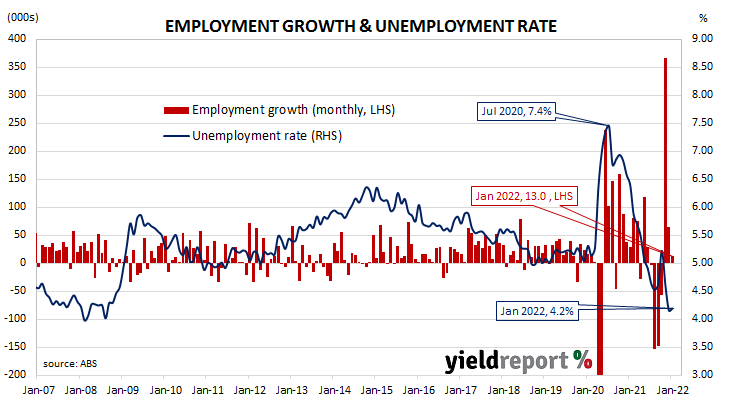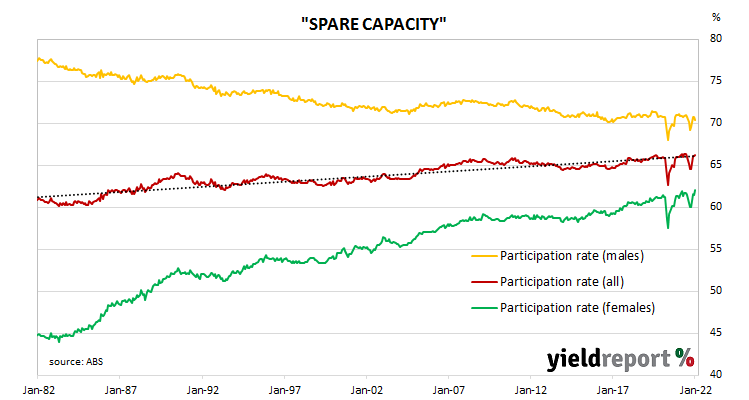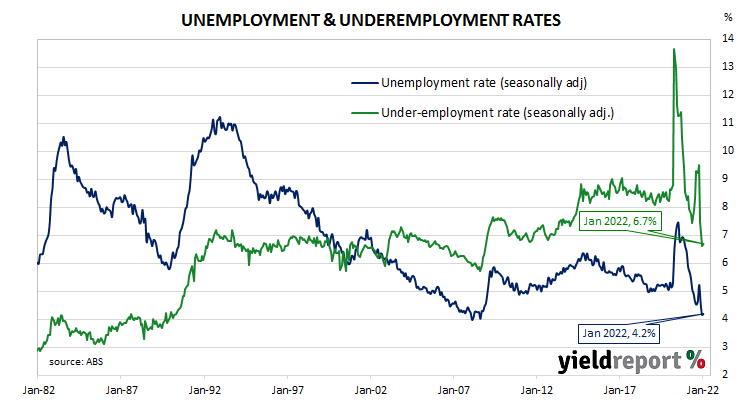Summary: Employment up 13,000 in January rise slightly higher than expected figure; figures “unremarkable” given Omicron’s disruption; reduced hours from sickness around three times pre-pandemic average in NSW, Victoria, up significantly elsewhere; people working no hours “particularly high”; participation rate ticks up to 66.2%; slightly more jobseekers, slightly larger workforce keeps jobless rate at 4.2%; more part-time, fewer full-time jobs; aggregate work hours down 8.8%; underemployment rate ticks up from 6.6% to 6.7%.
Australia’s period of falling unemployment came to an end in early 2019 when the jobless rate hit a low of 4.9%. It then averaged around 5.2% through to March 2020, bouncing around in a range from 5.1% to 5.3%. Leading indicators such as ANZ’s Job Ads survey and NAB’s capacity utilisation estimate suggested the unemployment rate would rise in the June 2020 quarter and it did so, sharply. The jobless rate peaked in July 2020 but fell below 7% a month later. It then trended lower through the remainder of 2020 and into 2021.
The latest Labour force figures have now been released and they indicate the number of people employed in Australia according to ABS definitions increased by 13,000 in January. The rise was slightly higher than the flat result which had been generally expected but not as great as December’s 64,700 increase.
ANZ senior economist Catherine Birch described the figures as “largely unremarkable given Omicron’s disruption to the economy”.
Domestic Treasury bond yields fell moderately on the day, although not quite as much as their US Treasury bond counterparts had overnight. By the close of business, the 3-year ACGB yield had shed 4bps to 1.67%, the 10-year yield had lost 3bps to 2.22% while the 20-year yield finished 2bps lower at 2.70%.
In the cash futures market, expectations of any material change in the actual cash rate, currently at 0.05%, remained fairly soft until the second half of 2022. At the end of the day, contract prices implied the cash rate would not exceed the RBA’s 0.10% target rate until May and then rise to 0.555% by August. February 2023 contracts implied a cash rate of 1.415%.
“The big hits occurred in New South Wales and Victoria where the number of people who worked reduced hours because they were sick was around three times the pre-pandemic average for January,” said Westpac senior economist Justin Smirk. “In other states and territories, it was twice as many people. The number of people working no hours at all in a week because they were sick was particularly high at more than four times the pre-pandemic average.”
The participation rate ticked up from December’s 66.1% to 66.2%, as the total available workforce increased by 21,000 to 13.835 million. The number of unemployed persons increased by 5,600 to 580,000; the slightly higher jobless number and a slightly larger number of people in the workforce resulted in the unemployment rate remaining at 4.2%.
The aggregate number of work hours across the whole Australian economy dropped significantly as 29,900 residents gained part-time positions and 17,700 residents lost full-time positions. In percentage terms, the total number of work hours fell by 8.8% after rising by 1.0% in December. On a 12-month basis and after revisions, aggregate hours worked declined by 0.5% as 68,300 more people held part-time positions and 291,300 more people held full-time positions than in January 2021.
In recent years, more attention has been paid to the underemployment rate, which is the number of people in work but who wish to work more hours than they do currently. January’s underemployment rate ticked up from 6.6% to 6.7%.
The underutilisation rate, that is the sum of the underemployment rate and the unemployment rate, has a strong correlation with the annual growth rate of the ABS private sector wage index when advanced by one quarter. January’s underutilisation rate of 10.9% corresponds with an annual growth rate of about 4.0%.




